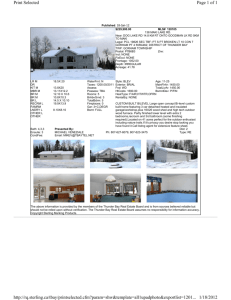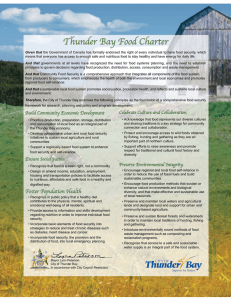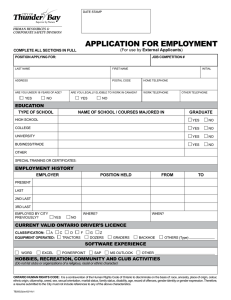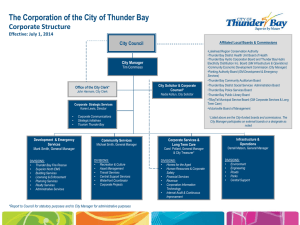Thunder Bay, Ontario - Great Lakes and St. Lawrence Cities Initiative
advertisement
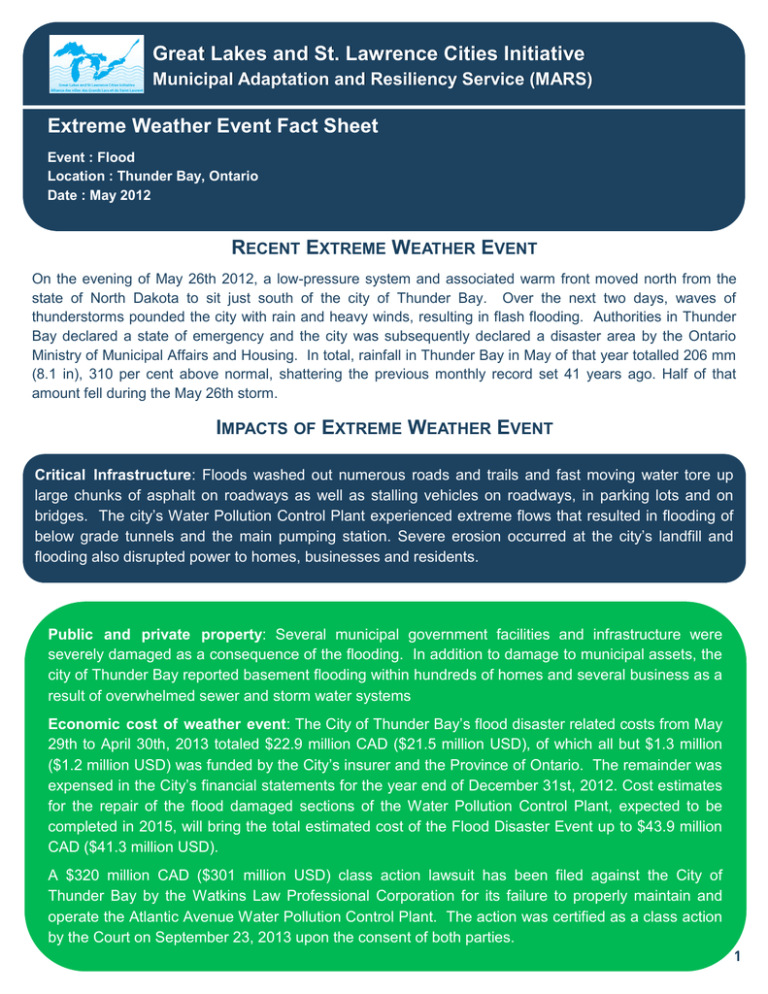
Great Lakes and St. Lawrence Cities Initiative Municipal Adaptation and Resiliency Service (MARS) Extreme Weather Event Fact Sheet Event : Flood Location : Thunder Bay, Ontario Date : May 2012 RECENT EXTREME WEATHER EVENT On the evening of May 26th 2012, a low-pressure system and associated warm front moved north from the state of North Dakota to sit just south of the city of Thunder Bay. Over the next two days, waves of thunderstorms pounded the city with rain and heavy winds, resulting in flash flooding. Authorities in Thunder Bay declared a state of emergency and the city was subsequently declared a disaster area by the Ontario Ministry of Municipal Affairs and Housing. In total, rainfall in Thunder Bay in May of that year totalled 206 mm (8.1 in), 310 per cent above normal, shattering the previous monthly record set 41 years ago. Half of that amount fell during the May 26th storm. IMPACTS OF EXTREME WEATHER EVENT Critical Infrastructure: Floods washed out numerous roads and trails and fast moving water tore up large chunks of asphalt on roadways as well as stalling vehicles on roadways, in parking lots and on bridges. The city’s Water Pollution Control Plant experienced extreme flows that resulted in flooding of below grade tunnels and the main pumping station. Severe erosion occurred at the city’s landfill and flooding also disrupted power to homes, businesses and residents. Public and private property: Several municipal government facilities and infrastructure were severely damaged as a consequence of the flooding. In addition to damage to municipal assets, the city of Thunder Bay reported basement flooding within hundreds of homes and several business as a result of overwhelmed sewer and storm water systems Economic cost of weather event: The City of Thunder Bay’s flood disaster related costs from May 29th to April 30th, 2013 totaled $22.9 million CAD ($21.5 million USD), of which all but $1.3 million ($1.2 million USD) was funded by the City’s insurer and the Province of Ontario. The remainder was expensed in the City’s financial statements for the year end of December 31st, 2012. Cost estimates for the repair of the flood damaged sections of the Water Pollution Control Plant, expected to be completed in 2015, will bring the total estimated cost of the Flood Disaster Event up to $43.9 million CAD ($41.3 million USD). A $320 million CAD ($301 million USD) class action lawsuit has been filed against the City of Thunder Bay by the Watkins Law Professional Corporation for its failure to properly maintain and operate the Atlantic Avenue Water Pollution Control Plant. The action was certified as a class action by the Court on September 23, 2013 upon the consent of both parties. Great Lakes and St. Lawrence Cities Initiative Municipal Adaptation and Resiliency Service (MARS) Extreme Weather Event Fact Sheet Event : Flood Location : Thunder Bay, Ontario Date : May 2012 WHAT CHANGES IN CLIMATE CAN THUNDER BAY EXPECT? As a result of climate change Northern Ontario is expected to experience an increase in annual temperatures, resulting in shorter winter seasons, rapid spring snow melts, and an increase in severe weather events. As well, Thunder Bay may be affected by lower water levels in Lake Superior, a further projected impact of climate change. MUNICIPAL RESPONSE AND LESSONS LEARNED With respect to emergency response, Thunder Bay’s Emergency Operations Centre (EOC) structure and process worked very well. To reduce the risks and confusion created by freelance response, Thunder Bay ensured it had strong coordination and communication with its response network. Going forward, the EOC needs capital investment to keep up to the demands of such events. Communications is critical and media engagement is key. Clear, regular and consistent messaging through multiple channels, including webpage, phone information line, Facebook page, community groups, is essential. Thunder Bay also fostered strong media relations, issuing 40 media releases and holding 21 media briefings during the flood event. The City found that social media can help gather information about situations in different parts of the city, and needs to be managed and integrated into emergency planning. For more information on MARS, visit http://www.glslcities.org/MARS.cfm or contact Nicola Crawhall, at nicola.crawhall@rogers.com. Photos : The Chronicle Journal (left), Thunder Bay News Watch (right) Funding for this program is provided by the Ontario Ministry of the Environment.



